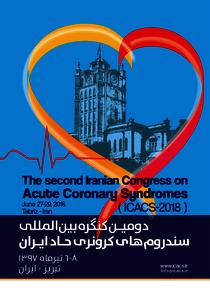زمانی, بیژن (1397) اقدامات اولیه کرونری در انفارکتوس. در: The second Iranian Congress on Acute Coronary Syndromes, Jun 27-29 , 2018, Tabriz - Iran.
متن کامل
![[img]](https://eprints.arums.ac.ir/10410/6.hassmallThumbnailVersion/photo_2017-11-01_12-45-10.jpg)
|
تصویر
138kB | |
|
متنی
128kB |
عنوان انگليسی
Primary PCI in STEMI
خلاصه انگلیسی
Primary percutaneous coronary intervention (PCI) has been established as the treatment of choice for patients presenting with acute ST elevation myocardial infarction (STEMI) and is associated with high success rate, low mortality in non-shock patients and low complication rates. STEMI was defined as symptoms of ischemia associated with ST-segment elevation of ≥1 mm in limb leads and/or ≥2 mm in chest leads in ≥2 contiguous leads, or new left bundle branch block, or true posterior myocardial infarction with ST depression of ≥1 mm in ≥2 contiguous anterior leads. There are no situations in which fibrinolytic therapy is preferred over primary PCI unless the patient refuses invasive procedures. Fibrinolytic therapy works best when symptom onset is < 3 hours since fresh thrombus lysis more readily than more organized, subacute thrombus. If symptoms have been present for >3 hours then primary PCI is preferred.The best outcomes occur when primary PCI is performed with a door-to-balloon time of < 90 minutes and when symptoms onset was < 12 hours.Primary PCI is only indicated when symptoms duration is 12-24 hours(delayed presentation) if severe congestive heart failure, hemodynamic/electrical instability or continued angina is present. Primary PCI is notrecommended when symptom onset is more than 12 hours and the patient isasymptomatic . Catheterization team was activated immediately on confirmation of STEMIdiagnosis. After loading with dual antiplatelets, patients were immediatelyshifted to catheterization laboratory. After gaining vascular access, non-culprit vessel angiogram was done firstfollowed by the culprit vessel angiogram. Once the decision to go aheadwith angioplasty was taken, heparin was administered in dosage of 70–100 U/kg to achieve an ACT of 250–300. GPIIb/IIIa inhibitor use was left tooperator's discretion. The choice of guidewire, balloon, stent, thrombusaspiration and IABP was on operator's discretion. Hemodynamically stable patients were kept in CCU for 24–48 h andsubsequently shifted to step down unit and were discharged on 4th or 5th day.At discharge statinsin dose of 40–80 mg and dual anti platelet (DAPT) agentswere prescribed to all patients. ACEI/ARB and beta blockers were used in allpatients without contraindications for their use. Important predictors significantly associated with mortality are the door toballoon time, Killip class, final TIMI flow and severe LV dysfunction
| نوع سند : | موضوع کنفرانس یا کارگاه (سخنرانی ) |
|---|---|
| زبان سند : | انگلیسی |
| نویسنده مسئول : | بیژن زمانی |
| موضوعات : | WG سیستم قلب و عروق |
| بخش های دانشگاهی : | دانشكده پزشكي > گروه داخلی ، قلب ، عفونی |
| کد شناسایی : | 10410 |
| ارائه شده توسط : | خانم زینب ایمانی |
| ارائه شده در تاریخ : | 25 مرداد 1397 11:24 |
| آخرین تغییر : | 25 مرداد 1397 11:24 |
فقط پرسنل کتابخانه صفحه کنترل اسناد




